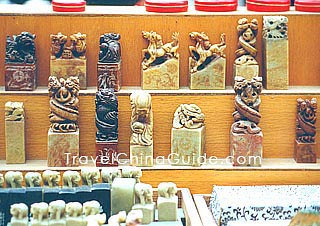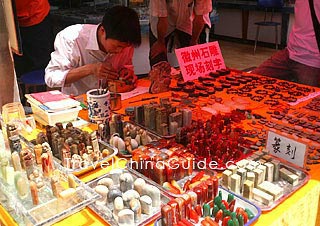Chinese Seals
 |
| Chinese Seals |
When foreigners negotiate, or register in certain areas of China, they may be surprised at Chinese' special fondness and preference for seals. To Chinese, seals are an art of deep cultural roots, which combines the essence of both calligraphy and engraving and inspires generations to study, to appreciate and to collect.
It is believed that seals came out as early as 8,000 years ago after our ancestors could make pottery wares and had private property. They were assumed to make marks on their own possessions to prevent theft. When the first dynasty was established, the king began to use seals to empower and to show lordly credits. Only the king's special seal was then called 'Xi', which represented the highest authority. The first emperor of China, Qin Shi Huang, had his 'Xi' made out of the invaluable and beautiful jade 'Heshi Bi'.
Then followed the local governments who needed seals for similar function. Simultaneously private seals were carved in a variety of auspicious characters and vivid animal patterns. Gradually the sphragistics came into being. Now many collectors' favorites are of that kind.
The heyday of seal history was during the Ming (1368-1644) and Qing (1644-1911) Dynasties when the feudal arts flourished. As wash paintings thrived, artists stamped their seal on the 'xuan,' a special kind of high quality paper used for painted scrolls in order to identify themselves and to add interest. Various sects of carving were erected by noted seal cutting sculptors.
 |
| A craftsman is making a seal |
The title, "Father of Seal Engraving" definitely belongs to Wen Peng, the son of Wen Zhenming, one of China's most famous calligraphers and painters. The charm of Wen Peng's engraving lay in the dainty mellowness of the cut and the elegant, flying characters. Although a master of his craft, what makes him the 'Father of Seal Engraving' was his ingenuity in introducing a longer lasting more durable material for seals. One day, the story goes, Wen Peng met an old man selling stones for women's headdress. The man was having a difficult time selling the stones; potential buyers had all proposed unreasonably low prices. When Wen Peng saw the stones, it suddenly occurred to him that they could be used as seals. He bought the stones at a high price, helping the old man out of his predicament. When he returned home, he cut the stones with great strength, producing the most delicate of seals. The first stone seal emerged. Until that time, seals had been made of bronze or pottery.
Another noted seal engraver was He Zhen of the late Ming Dynasty. He used the graver steadily and neatly with strength and vigor, and the curves of each character were quite clear and harmonious. His works stopped the vogue of affectation and influenced the engravers of the Qing Dynasty.
The genre of seal is greatly determined by the strength and speed of wrist and hand. Seals, like a person's character, are distinctive from each other. A sanguine seal engraver makes deft and buoyant strokes while a sober person makes careful and neat ones.
Seal carving also requires choice materials like metal, jade, animal teeth and horns, pottery, bamboo, fruit-pits, and stones. A good material should feel slippery, smooth, cool at first but warm after a second; when cut, it should have certain flexibility. Qingtian stone, Tianhuang stone, Balin stone and 'chicken's blood stone' (Jixue shi) are all first-class materials among stones used for seal cutting. Tianhuang stone features its translucency; 'chicken's blood stone, the red dapples.